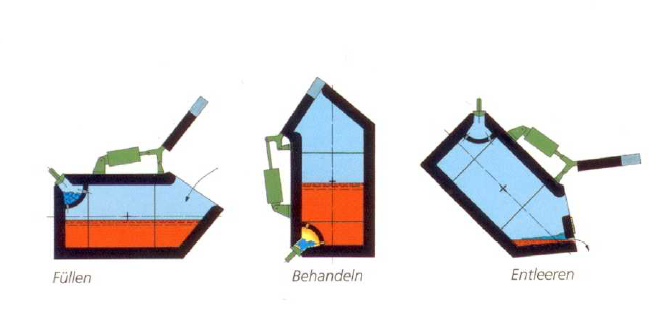Georg Fischer converter process
Magnesium treatment process to create cast iron with nodular graphite, developed by Georg Fischer AG, Schaffhausen/Switherland.
In most production processes for cast iron with nodular graphite (GJS), magnesium is adapted to the physical reaction conditions through pre-coating (see also Magnesium master alloy) or through another treatment. In the pure magnesium conversion process, the constructive converter structure enables a controlled reaction with pure magnesium.
During the treatment, a basically constant amount of magnesium vapor rises through the melt from the reaction chamber in the converter floor. This way, the melt is desulfurized and alloyed. Due to the intensive flushing effect, a good reaction product separation is achieved. The iron magnesium reaction progress in influenced by chamber wall bores positions, form and size as well as by the self-regulation effect which is specific for this process. The converter is filled in a horizontal position with a weighed amount of iron melting base (see Melting base). After that, the reaction chamber is filled with pure magnesium from the outside and locked. Once the converter is set up vertically, a regulated magnesium iron reaction begins without increasing pressure (Fig. 1).
During the reaction - a treatment takes 60 to 90 seconds - the melt is deoxydized and later desulfurized. Only if the sulfur content is below 0.002 percent, the melt absorbs magnesium. Even base iron with a high sulfur content of 0.2 to 0.3 percent can accurately be transformed into cast iron with nodular graphite. Parallel to the magnesium treatment, the melt can be carburized - also by using a cost-effective highly sulfurous carburization medium (1 percent of sulfur) - with a c yield of constantly more than 80 percent.
The temperature loss per treatment without carburization amounts to 22 to 30 °C for the 1 ton converter and to 18 to 25 °C for the 3 ton converter. For each 0.1 percent of additional C, the increase by 3 °C. On the contrary to pre-alloy processes, the pure magnesium treatment does not comprise the addition of elements such as silicon, nickel, aluminum, etc. This allows for an unrestricted use of the GJS circulation material and an individual setting of the Si content. Thanks to the independence when setting the Si content, the brittle Si phase can be avoided and a better impact strength ca be achieved. The pure magnesium process ensures a high treatment reproducibility and a high magnesium yield of up to 70 percent.
The converter can be used in different versions, e.g. swing converters, forklift truck converters, monorail converters, high performance converters. Fig. 2 exemplifies a crane converter during furnace emptying.
Additional references:
Magnesium fading
Magnesium treatment wire
Magnesium residual content
Residual magnesium content
Tundish Cover process
Tea pot treatment ladle
Inmold process



